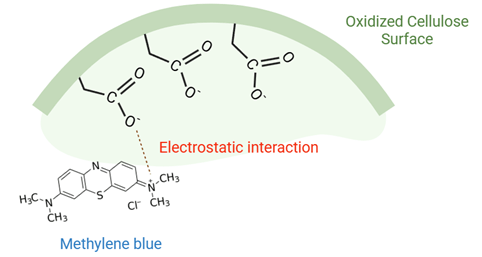 Open Access
Open Access
ARTICLE
The Adsorption Properties of TEMPO Oxidized Cellulose against the Mixture of Methylene Blue and Rhemazol Yellow FG
Program Studi Kimia, Fakultas Sains, Insitut Teknologi Sumatera, Jalan Terusan Ryacudu, Way Huwi, Jati Agung, Lampung Selatan, 35365, Indonesia
* Corresponding Author: I. Putu Mahendra. Email:
Journal of Renewable Materials 2024, 12(8), 1369-1382. https://doi.org/10.32604/jrm.2024.053001
Received 22 April 2024; Accepted 17 June 2024; Issue published 06 September 2024
Abstract
TEMPO/NaOCl/NaBr treatment significantly increased the number of negative charges on the cellulose surface. Two concentrations of NaOCl, 5 and 30 mmol/g of cellulose, were used in this study. The number of carboxyl groups in the two cellulosic samples oxidized using TEMPO/NaOCl/NaBr was 0.5160 and 1.8461 mmol/g of cellulose, respectively. The oxidized cellulose samples treated with 5 and 30 mmol/g NaOCl exhibited higher crystallinity, at 81.15% and 80.14%, respectively, compared to untreated cellulose, which had a crystallinity of 75.95%. The pH effect indicated that the highest adsorption capacity for methylene blue was achieved under alkaline conditions (pH 9), while the highest adsorption capacity for rhemazol yellow FG was achieved under acidic conditions. The kinetic model of TEMPO-oxidized cellulose for methylene blue and rhemazol yellow FG conformed to the pseudo-second-order model. The initial concentration parameter revealed that the isotherm model for the adsorption of methylene blue and rhemazol yellow FG by TEMPO-oxidized cellulose conformed to the Langmuir model. The dye removal efficiencies for methylene blue and rhemazol yellow FG using TEMPO-oxidized cellulose (30 mmol/g) were approximately 80.17% and 59.52%, respectively. These results demonstrate that TEMPO/NaOCl/NaBr-oxidized samples can effectively separate cationic and anionic dye mixtures. Furthermore, the use of TEMPO-oxidized cellulose showed good regeneration capability, maintaining more than 95% of its adsorption capacity after 8 cycles.Graphic Abstract

Keywords
Cite This Article
 Copyright © 2024 The Author(s). Published by Tech Science Press.
Copyright © 2024 The Author(s). Published by Tech Science Press.This work is licensed under a Creative Commons Attribution 4.0 International License , which permits unrestricted use, distribution, and reproduction in any medium, provided the original work is properly cited.


 Submit a Paper
Submit a Paper Propose a Special lssue
Propose a Special lssue View Full Text
View Full Text Download PDF
Download PDF Downloads
Downloads
 Citation Tools
Citation Tools
